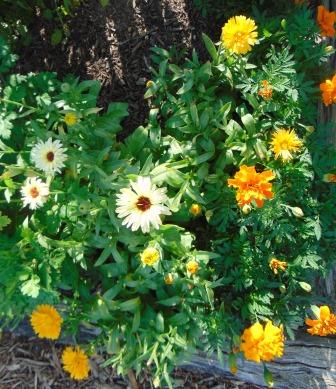There are many good reasons to deadhead. For those of you new to gardening, deadheading is the removal of faded flowers. The first reason is that it immediately makes a garden look fresher, tidier, and happier. Here’s a tiny corner of the potager containing violas and calendulas with lots of faded flowers. See how tired it looks with those beginning seed pods? 
And here it is minutes later, looking refreshed and ready to push all those tiny baby buds into flowers.  Deadheading cool weather flowers like violas, nasturtiums and calendulas can encourage them to keep producing bountiful flowers and remain more compact as the weather heats up. Visitors to my gardens often comment that their violas and pansies gave up weeks ago. Deadheading is the key to longer production.
Deadheading cool weather flowers like violas, nasturtiums and calendulas can encourage them to keep producing bountiful flowers and remain more compact as the weather heats up. Visitors to my gardens often comment that their violas and pansies gave up weeks ago. Deadheading is the key to longer production.
The second reason is more important, especially for annuals. An annual’s sole purpose in life is to propagate. Once a flower begins to fade, if it was pollinated, the plant immediately begins to spend energy turning that faded flower into a seed capsule. And, once that plant has successfully produced seed it says, “Hurrah! My job is finished. Now I can retire and just enjoy the rest of the summer.” But, if the faded flower is removed, the plant’s response is, “Wow! I’d better produce some more flowers!” The energy that would have been used to produce seed is spent making more flowers. So, deadheading produces more flowers, especially in annuals.
Perennials have a much smaller bloom period, usually 1-3 weeks and then they are finished until they return next year. If you don’t deadhead, you’ll have to look at those brown stalks and shriveled flowers until a strong wind blows them away or they turn to mush. The energy that could have been used to produce stronger root systems and additional flowers next year is put into seed that you probably don’t want anyway. It may not come true to form, or will fall down around the mother plant and eventually smother her. The strong seed producers, like black-eyed Susans and coneflowers can soon take over an entire perennial border.
The third reason to deadhead is to keep that mulching chore you worked so hard at early in the season looking good. A pile of wilted daylily or snapdragon blooms can soon make your lovely mulch almost disappear. I still remember visiting Kew Gardens very early one morning. The gardeners were embarassed that I was photographing in the rose garden before they had vacuumed up all the fallen petals. Sometimes I actually love a drift of fallen petals, but usually what I see is waste. And that brings me to reason number four.
Those of you who know me well, know that I hate to waste effort or product. So, when I deadhead roses the petals go into rose water. Calendula petals get dried for teas or go into oil for salve. For pansies or violas, I throw the dark colored ones into one basket, the yellow and orange into others. Then I make “colored flower sugar” by putting equal parts petals and sugar in a food processor. The result is a beautiful sugar that I can sprinkle on top of buttered toast for Fairy Teas, substitute into sugar cookies, pound cake, etc. Some of the flowers have a delicate flavor. Here’s the Flower Shortbread recipe that I always made for “Viola Day” at my old herb farm. It has become one of the family’s favorites!
Carolee’s Flower Shortbread
In food processor, mix ½ c. dark purple pansy or viola petals (be sure no harmful chemicals or sprays have been used on them). I usually rinse them and dry between paper towels before I remove the petals from the stems. Add ½ c. sugar, and process until petals are nearly the size of the sugar crystals. Preheat oven to 350 degrees. Measure 1/2 c. purple sugar into a small mixing bowl. Add ½ c. (1 stick) unsalted butter and cream until light and fluffy. (With yellow petals I often add a bit of lemon zest, with orange petals, a bit of orange zest, etc.)
Add 1 c. all-purpose flour, mixing until dough is formed. It will be slightly crumbly. Pour onto a parchment covered baking sheet. With clean hands, press dough into a 7” square. With a floured knife, cut into 16 squares. You may also want to make a design with the tines of a fork on each cookie. Bake about 30 min, just until they begin to brown. Cool.

Oh goodness…You are a super woman.
LikeLike
I love the idea of flower sugar!
LikeLike
That sounds lovely! And thank you for the tip, I always need tips!
LikeLike
Flower sugar sound like a brilliant idea .. I’ll definitely be using that idea! Thanks
LikeLike
This was really informative, thank you.
LikeLike
Well said. I’m with you. I have been deadheading plants for over almost 30 years of gardening. You summed up the reasons to do so perfectly. Thanks for validating this process … as my family members sometimes think I manicure my garden too much. : ) jan
LikeLike
Wow, I deadhead but am sort of hit-and-miss about it. This is great motivation. And… viola sugar… mmmmmmmmmm…..
LikeLike
I deadhead quite religiously too. However it brings up a point. What’s the difference between just deadheading or cutting back a perennial bush like salvia? They are so hardy after the first flush, I cut it back quite drastically and it produces even more.
LikeLike
I had no idea the benefits of dead heading! I have just been doing it because my grandmother always made us “neaten” the garden before going out to play – this has held over to adulthood. Thank you for the flower sugar recipe, I will be trying that out soon.
LikeLike
You are welcome. Deadheading does make the garden prettier and encourages annuals to produce more flowers. You were blessed with a grandmother who taught good gardening practices.
LikeLike
I am so glad you made your way to my site! We make calendula gel, tea and rosewater for the bath and skin. I have not used the flowers for sugar before. I will be trying it now.
I will be following your blog, can’t wait to read your earlier posts.
LikeLike
Herbs were my profession and passion for over 50 years. It always delights me to see people using them, appreciating them for their amazing qualities and beauty. Best of luck in your herbal journey.
LikeLike